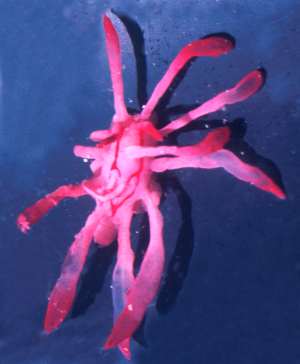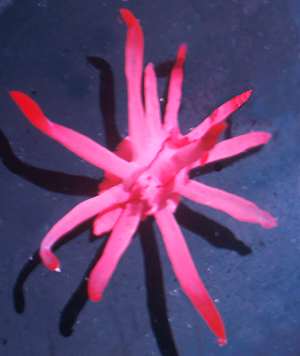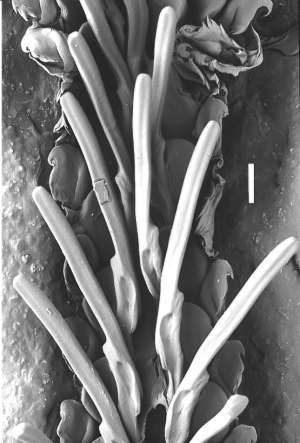
Okenia stellata
Rudman, 2004
Order: NUDIBRANCHIA
Suborder: DORIDINA
Superfamily: ANADORIDOIDEA
Family: Goniodorididae
DISTRIBUTION
Northern Australia from Western Australia (Kimberley, Exmouth Gulf), Northern Territory, Queensland, northern New South Wales.
PHOTO
Upper Right, Lower Left: Heron Is, Queensland, Australia, August 1981, 10 mm preserved. AM C131365. Lower Right: SEM of radula, showing part of complete ribbon. Note large rodlike inner lateral teeth and small platelike, denticulate, outer teeth. Lady Elliot Is., Queensland, Australia, 17 m, 15 January 1983, 18 mm long alive. Scale bar = 100 µm. Photos: G. Avern.
The animal is ovate and dorso-ventrally flattened with no mantle edge to distinguish the dorsum from the sides of the body or the foot. There are 5 large, and relatively long, lateral papillae on each side which point out at right angles to the edge of the body forming a star-like radiating pattern. They are usually held out horizontally, with the tips curved slightly upwards. The basal part of the lateral papillae is cylindrical, but the outer half to two-thirds becomes broader and dorso-ventrally flattened before tapering to a pointed tip. There is also a similar shaped papilla in the dorsal midline just in front of the gills, which is usually held erect. The rhinophores are short, about a third the length of the lateral papillae, and there are usually 3 small gills, arranged in an arch around the anus. From above the head cannot be distinguished from the foot, and there are no oral tentacles.
The animal is pink with a deeper reddish tint to the tips of the mantle papillae and to the rhinophore club. The gills have a deeper red band up their smooth outer edge. There is also a pattern of thin red lines on the dorsum, including a ring around the body just below the papillae, which is usually partly hidden from above by the lateral papillae. There are also 2 lines on the dorsum which run from the behind each rhinophore back around the gills and join in the dorsal midline behind the gills. The line also runs up the posterior midline of each rhinophore stalk to the base of the lamellate club. Sometimes there can be a secondary tranverse line running across in front of the gills. Parts of these lines are often missing in individual animals.
The shape of the radular teeth is very unusual for the Goniodorididae. The inner teeth have a wide base and a long rod-like blade which is bluntly rounded at the tip. There is a rounded groove running the length of the posterior face. There are no denticles. The much smaller outer teeth have a broad rounded base and up to 4 recurved pointed cusps along the outer edge of the tooth.
Okenia stellata is named from the star-like arrangement of the lateral papillae. This species has similarities to Okenia nakamotoensis (Hamatani, 2001), which also has 5 pairs of lateral papillae, but they are shorter and the tips are swollen with a rounded point. In both species the head and foot have merged, and in both the inner radular teeth are long and rod-like but in O. nakamotoensis, they are slender with a recurved hook-like tip, a feature found only in this species and Okenia rosacea (MacFarland, 1905). There are a number of species with this bright pink colour pattern. Two of them, O. nakamotoensis and Okenia kondoi are found together on the branching erect, but calcareous bryozoan, Tropidozoum cellariforme Harmer, 1957. Okenia stellata is part of another pair of species, living with another pink species, O. hallucigenia, on another branching, erect, but calcareous bryozoan, Pleurotoichus clathratus. Observations from Western Australia, Queensland and New South Wales all note its association with this bryozoan.
-
Rudman, W.B. (2004) Further species of the opisthobranch genus Okenia (Nudibranchia: Goniodorididae) from the Indo-West Pacific. Zootaxa, 695: 1-70.


Rudman, W.B., 2004 (December 21) Okenia stellata Rudman, 2004. [In] Sea Slug Forum. Australian Museum, Sydney. Available from http://www.seaslugforum.net/factsheet/okenstel
